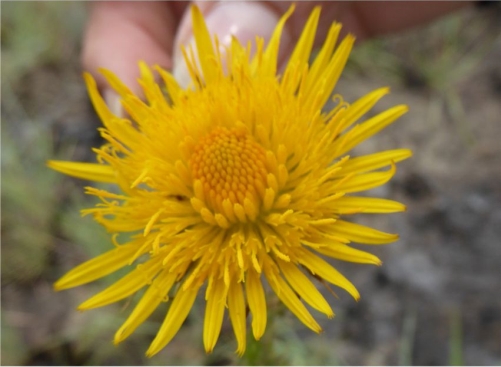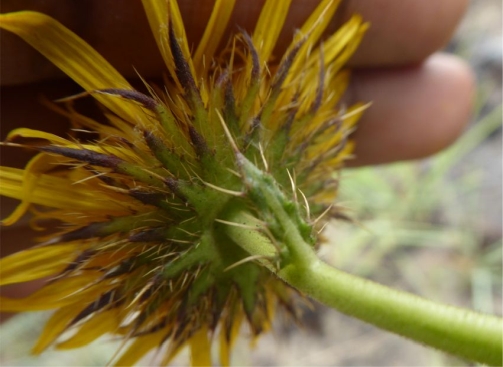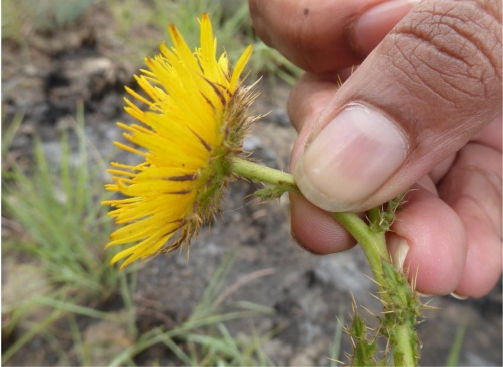Berkheya griquana
Berkheya griquana Hilliard & B.L.Burtt
Family: Asteraceae
Common names: East Griqualand African thistle, East Griqualand berkheya (Eng.); Griekwaland-Oos-bergdissel (Afr.)
Introduction
This robust yellow African Thistle flourishes in the grasslands of East Griqualand.

Fig. 1. Bright yellow flower head of Berkheya griquana.
Description
Description
This spikey African thistle is a long-living herb, characterized by elongated, woody, underground stems that grow horizontally beneath the surface, producing roots and aerial stems. The stems can grow to about 1 m in height, with a large, corymbose panicle inflorescence. The leaves of Berkheya griquana grow up to approximately 180 x 30 mm in size. The leaf shape ranges from having a rounded apex and tapering base, to being rounded at each end with parallel sides, with leaf tips that are generally sharp. All the leaves have long, sharp spikes and fine hairs. The lower leaves taper into the petiole, while the upper leaves remain broader. The leaf margins vary from faintly to distinctly lobed. The indentations between the lobes are relatively serrated, with spikes that are about 7 mm long. The leaf edges are also armed, with shorter spikes. The upper side of the leaf has finer, shorter hairs with some longer, coarser hairs while the under side of the leaf has hairs only along the leaf veins.

Fig. 2. Leaves of Berkheya griquana.
The flower head is daisy-like, approximately 40 mm in diameter. There are between 10-13 involucral bracts present, which are approximately 1.5-2 mm in length. The involucral bracts are narrow and parallel-sided in the middle and taper to a slender base with an acute tip. The edges of the bracts are very spikey, typically in threes, with gland-tipped hairs. The spikes are approximately 2.5-4 mm in length. The flowers of Berkheya griquana are about 12 mm in length and radiantly yellow. The fruit is an achene, about 2.5 mm in length. The dry, one-seeded fruit is shaped like an inverted cone, with fine hairs and does not open to release seeds. The fruit also has about 10 pappus scales that are separate, 0.75 mm in length, with short and relatively sharp tips.

Fig. 3. Involucral bracts of Berkheya griquana.
Berkheya griquana is similar to Berkheya bergiana, however, it is differentiated from the latter species, which has rough glandular hairs on the upper surface of the leaves and pappus scales that are 0.2-0.5 mm in length.
Conservation Status
Status
Berkheya griquana is currently assessed as Vulnerable (VU) on the Red List of South African Plants. This species was listed as Data Deficient prior to the last Red List assessment conducted in 2008. Berkheya griquana is known only from a few localities, where populations are impacted by anthropogenic factors such as livestock grazing and pollution. In the summer of 2019, the CREW KZN Node visited two of the known localities and discovered that the sites were in poor condition with about 20 plants observed in the overgrazed parcels of grassland, growing along the roadside where grazing cattle and litter were observed.

Fig. 4. Berkheya griquana in its natural habitat.
Distribution and habitat
Distribution description
Berkheya griquana is a South African endemic species found in the East Griqualand grasslands within the Eastern Cape and KwaZulu-Natal. The species has a restricted range, and occurrs in an area of less than 100 km².
Derivation of name and historical aspects
History
In 1788, German botanist Jakob Ehrhart labelled a group of Asteraceae plants that resembled thistles as Berkheya. The genus was named after Dutch botanist, Jan le Francq van Berkhey. In 1985, Olive Hilliard and Brian Burtt described Berkheya griquana, naming it in honour of the Griqua people of Griqualand, the area in which the species was first discovered.

Fig. 5. Side view of a flower head of Berkheya griquana.
Ecology
Ecology
Little is known about the ecology of Berkheya griquana, however, like most species within this genus, potential pollinators may include insects such as beetles, butterflies and bees.
Uses
Use
There is no record of traditional, economic or medicinal uses for Berkheya griquana thus far.

Fig. 6. Berkheya griquana in bud.
Growing Berkheya griquana
Grow
Little is known about the propagation of Berkheya griquana, however, as with most species within the genus, full sunlight and well-drained soils with basic, acidic, or neutral pH levels would be optimal.
To cultivate Berkheya species from seed, place seeds in well-drained soils, preferably loam or clay, and lightly cover the seeds with the soil. Monitor and spray the soil with a reasonable amount of water on a regular basis to ensure that the soil remains damp. Do not over-saturate the soils with water as this may result in drowning or the rotting of the seeds. The germinating seeds will begin to sprout within a month and can be relocated into pots or a flowerbed in the second month of growth.
References
- Gumede, S. 2022. Berkheya multijuga (DC.) Roessler. (Asteraceae). PlantZAfrica. Online. https://pza.sanbi.org/berkheya-multijuga.
- Hayloft Plants. How to Grow Berkheya. https://hayloft.co.uk/growingberkheya. Accessed 16/01/2023.
- Hilliard, O.M. & Burtt, B.L. 1985. Notes on some plants of southern Africa chiefly from Natal: XI. Notes from the Royal Botanic Garden Edinburgh 42(2):227-260.
- Hilliard, O.M. & Burtt, B.L. 1988. Notes on some plants of southern Africa chiefly from Natal: XV. Notes from the Royal Botanic Garden Edinburgh 45(2):179-223.
- Kamundi, D.A. & Raimondo, D. 2008. Berkheya griquana Hilliard & B.L.Burtt. National Assessment: Red List of South African Plants version 2020.1. Accessed on 2022/12/22
- Ndlovu, B. 2020. Berkheya setifera DC. (Asteraceae). PlantZAfrica. Online. https://pza.sanbi.org/berkheya-setifera.
- Retief, E. & Meyer, N.L. 2017. Plants of the Free State inventory and identification guide. Strelitzia 38. South African National Biodiversity Institute, Pretoria.
- Van der Walt, L. 2005. Berkheya purpurea (DC.) Mast. .(Asteraceae). PlantZAfrica. Online. https://pza.sanbi.org/berkheya-purpurea.
Credits
Kaveesha Naicker
Custodians for Rare and Endangered Wildflowers (CREW) – Summer Rainfall Region
January 2023
Plant Attributes:
Plant Type: Perennial
SA Distribution: Eastern Cape, KwaZulu-Natal
Soil type: Sandy, Loam
Flowering season: Early Summer
PH: Acid, Neutral
Flower colour: Yellow
Aspect: Full Sun
Gardening skill: Average
Special Features:
Horticultural zones







Rate this article
Article well written and informative
Rate this plant
Is this an interesting plant?
Login to add your Comment
Back to topNot registered yet? Click here to register.